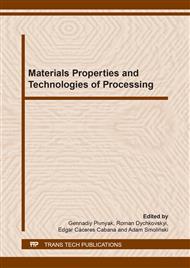[1]
Rudobashta, S., Zueva, G., & Zuev, N. (2014). Mathematical modeling and numerical simulation of oscillating infrared seeds drying process. Drying Technology: An International Journal, 32(11), 1352-1359.
DOI: 10.1080/07373937.2014.892508
Google Scholar
[2]
Fedosov, S.V. (2010). Heatmasstransfer in technological processes of building industries. Ivanovo: PK «PressSto.
Google Scholar
[3]
Dudin, O., & Barabanshchikov, Yu.G. (2015). Install wiring specificity in technology of heating the concrete. Construction of the unique buildings and structures, (9), 47-65.
Google Scholar
[4]
Valt B., & Ovchinnikov A.A. (2008). Ways of thermal treatment of concrete in cast-in-place constructions. Izvestiya KGTU, (13), 109-112.
Google Scholar
[5]
Burdo, O.G., Zykov, O.V., & Gaida, S. (1999). New principles of grain thermal treatment. Scientific works of Odessa State Academy of Food Technologies, (20), 223-229.
Google Scholar
[6]
Ilin, S.R., Samusia, V.I., Ilina, I.S., & Ilina, S.S. (2016). Influence of dynamic processes in mine hoists on safety of exploitation of shafts with Broken geometry. Naukovyi Visnyk Natsionalnoho Hirnychoho Universytetu, (3), 48-53.
DOI: 10.29202/nvngu/2018-5/10
Google Scholar
[7]
Chernai, A.V., Sobolev, V.V., Chernai, V.A., Ilyushin, M.A., & Dlugashek, A. (2003). Laser ignition of explosive compositions based on di-(3-hydrazino-4-amino-1,2,3-triazole)-copper(II) perchlorate. Combustion, Explosion and Shock Waves, 39(3), 335-339.
DOI: 10.1023/a:1023852505414
Google Scholar
[8]
Pivnyak, G., Dychkovskyi, R., Bobyliov, O., Cabana, E. C., & Smoliński, A. (2018). Mathematical and Geomechanical Model in Physical and Chemical Processes of Underground Coal Gasification. Solid State Phenomena, 277, 1-16. https://doi.org/10.4028/www.scientific.net/ssp.277.1.
DOI: 10.4028/www.scientific.net/ssp.277.1
Google Scholar
[9]
Saik, P.B., Dychkovskyi, R.O., Lozynskyi, V.H., Malanchuk, Z.R., & Malanchuk, Ye.Z. (2016). Revisiting the underground gasification of coal reserves from contiguous seams. Naukovyi Visnyk Natsionalnoho Hirnychoho Universytetu, (6), 60-66.
DOI: 10.29202/nvngu/2019-5/4
Google Scholar
[10]
Beshta, O.S. (2012). Electric drives adjustment for improvement of energy efficiency of technological processes. Naukovyi Visnyk Natsionalnoho Hirnychoho Universytetu, (4), 98-107.
DOI: 10.29202/nvngu/2019-2/12
Google Scholar
[11]
Vypanasenko, N.S. (2009). Mathematical model for analysis of thermal processes of induction heating of cylindrical joints of steel parts. Visnyk of Vinnytskyi Polytechnic Institution, (2), 60-65.
Google Scholar
[12]
Dreshpak, N.S. (2009). Modes of induction heating of cylindrical parts joined with the interference fit. Technical electrodynamics, (6), 61-66.
Google Scholar
[13]
Vypanasenko, N.S. (2008). Determination of power density of surface of induction heating of the parts joints done with interference fit. Visnyk of Pryazovskyi State Technical University, 18(2), 131-136.
Google Scholar
[14]
Dreshpak, N.S. (2011). Induction heating in electrotechnology of dismantling of the parts joints: monograph. D.: National Mining University.
Google Scholar
[15]
Pivnyak, G., Razumny, Y., Zaika, V. (2009). The problems of power supply and power saving in the mining industry of Ukraine. Archives of Mining Sciences, 54(1), 5-12.
Google Scholar
[16]
Pivnyak, G., Beshta, A., & Balakhontsev, A. (2010). Efficiency of water supply regulation principles. New Techniques and Technologies in Mining, 1-7. https://doi.org/10.1201/b11329-2.
DOI: 10.1201/b11329-2
Google Scholar
[17]
Vypanasenko, S.I. & Azam Al Satry (2002). Discrete control of power in electrotechnical installation of induction heating. Technical electrodynamics, (7), 66-68.
Google Scholar
[18]
Meshcheryakov, L.І., & Klochko, U.V. (2007). Software of intellectual support for drilling complexes control. Mining Electromechanics and Automation, (78), 68-75.
Google Scholar
[19]
Meshcheryakov, L.І. (2007). Intelligent diagnostics of drilling complexes. Collection of scientific papers of the National Mining University, (29), 132-141.
Google Scholar
[20]
Samusia, V., Kyrychenko, V., Kyrychenko, Ye., Ilina, S., & Antonenko, А. (2017). Hydro-thermodynamic model of deep-water hydraulic lift of 3-phase fluid considering heat-mass-exchange processes. Mining of Mineral Deposits, 11(2), 96-102. https://doi.org/10.15407/mining11.02.096.
DOI: 10.15407/mining11.02.096
Google Scholar
[21]
Kyrychenko, Y., Samusia, V., & Kyrychenko, V. (2012). Software development for the automatic control system of deep-water hydrohoist. Geomechanical Processes During Underground Mining, 81-86. https://doi.org/10.1201/b13157-14.
DOI: 10.1201/b13157-15
Google Scholar


